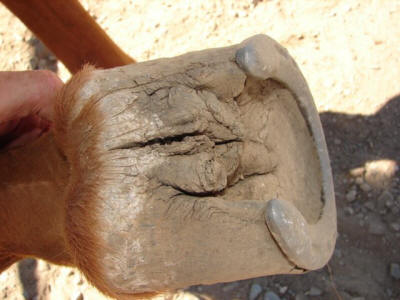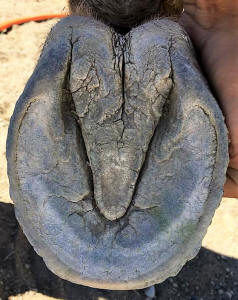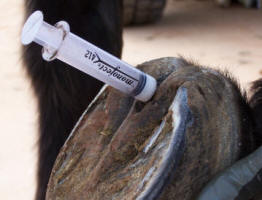Thrush Treatment Pete Ramey
Often overlooked, central and collateral groove
infections cause severe lameness in the back of the foot, which can then
cause chronic toe-first impact, which in turn can cause distal descent of
P3, thin soles at the toe, subsolar abscesses, hoof capsule rotation, wall
flare, wall cracks, navicular damage, ligament and tendon injuries
throughout the distal limb.... In short, every energy dissipating feature of
the foot can be completely erased by the pain of a simple frog infection,
and the gait of the horse altered into a destructive force --every step.
I use Monoject 412 syringes to thoroughly flush the deep sulci with warm soapy water or apple cider vinegar, and also to treat all the way to the bottom of the sulci with treatment salve (see 2019 edit below). It is best to do this daily if an infection or otherwise deep or tight central sulcus is causing pain or compensative movement.
Alternately, a 60cc catheter tip syringe is easier to use and is more resistant to clogging if none of the sulci you are treating are tight (the tip on these is pencil sized). These are usually okay for wet environments, but can be too fat in dry environments where insertion of the fatter tip is often painful or impossible.
An assortment of “Goos” work well, and the best one
will vary from one environment to the next. So it is best to switch formulas
if one isn’t working. Remember, though, better nutrition and pressure and
release stimulation are the real keys to healthy frogs -- the primary cause
of persistant or recurring thrush is usually either carbohydrate overload,
nutritional deficiency/imbalance, or both --
Read more here. It is worth
mentioning that wet environment horses tend to respond best to treatments
that are mixed heavier on the antifungal side. Desert horses tend to respond
best to treatments that are mixed with more antibacterial ingredients. But
this can vary, no matter where you are.
Whatever you use, it needs to kill fungi AND bacteria –
bonus points if it kills fungal spores. Most importantly, though, it cannot harm the new tissue
attempting to grow in the bottom of the sulci. It also cannot cause stinging
or burning that would cause toe-first impact and/or a lack of voluntary frog
use. This is critical, as most thrush treatments historically used do a
great job of killing the pathogens, but actually make deep infections
deeper, by excessively drying up or even eating away at young tissue growing
in the bottom of the sulcus.
I have long said that if you are
considering applying a treatment into a deep central or collateral sulcus
(or white line infection), first explore your own body and find your most
sensitive spot. Apply it there. If you have no adverse effects, the
treatment might be appropriate for a deep frog sulcus. It was my own
sensitive parts that originally led
me to the human salves and creams.
There are numerous herbal remedies that do well in the Monoject 412. Each are okay in my estimation, as long as they fit the above criteria.
Currently, I mix 8 ounces (250 ml) of generic extra strength Desitin (40% zinc oxide cream) with two teaspoons (10 ml) of copper sulfate powder. This sticks to the frogs (and all over me) better than anything I have tried, and has the possible advantage of being an antiseptic, rather than antibiotic. Keep the solution at room temperature or close to your body in winter to avoid clogging of the syringe.
Important: If you source copper sulfate crystals, rather than powder, use a mortar and pestle to grind it into a fine powder prior to mixing.
This is a big switch for me -- for almost 20 years I
used a 50/50 mixture of generic Bacitracin Cream or Neosporin Plus Pain and
human Athletes Foot Cream (1% Clotrimazole). I have cured thousands of deep
thrush cases with it, but am now shying away from the antibiotic cream in
favor of antiseptics because of concerns about creating antibiotic-resistant
bacteria strains.
A 50/50 mixture of 40% zinc oxide cream/Athletes Foot
Cream (1% Clotrimazole) works very well – I have recommended it overseas for
15+ years (topical antibiotics are prescription drugs in most countries
outside the US) and gotten a lot of positive feedback on the mixture.
Whatever mixture you choose,
stir it together in a jar or plastic container with a sealable lid. Then
pull the plunger out of your catheter tip dosing syringe or applicator and top load a half syringe-full with a butter knife or
Popsicle stick. Most concoctions are too thick to draw up into the syringe.
When using the Monoject 412, for most sulci, I cut ½” (12mm) off the tip of each syringe as the stock tip
is too skinny for cream to pass through it. Use only a pea-sized amount with most applications –
the trick is WHERE you treat: all the
way in the bottom of the lesion. Treat daily until the entire sulcus is
open to air, with no wet, anaerobic areas or sensitivity remaining.
2019 edit: The zinc oxide cream and many home-made versions tend to clog tapered dispensers like the Monoject 412. After experimenting with an assortment of parallel-sided applicators I have settled in on my new favorite setup, the Agir-Pro Ape Plex 10cc Luerlock Syringe (replacement O-rings can be purchased at the same link) with Stainless steel blunt tip Luerlock dispensing needles. My favorite size for zinc oxide cream/copper sulfate cream is the 12 gauge, but I like owning the assorted sizes in the kit linked above to accommodate different temperatures, mixtures and sulcus presentations.
Use these metal tips with great caution -- lay the tip into the sulcus sideways so that you don't risk stabbing the horse. Pushing the tip straight into the sulcus instantly clogs it anyway. For beginners, or if you don't deal with any deep, tight sulci, Luerlock teat cannulas are a considerably safer option (read totally idiot-proof).
.jpg)
Agri-Pro Ape Plex 10cc Luerlock Syringe (bottom) and standard 10cc Luerlock Syringe, both outfitted with Luerlock teat cannulas (very safe for extremely sensitive sulci and/or clumsy hands, but too flimsy for tight desert sulci or prying into tight crevases).
Rather than choosing
between the two methods, t
Most people tend
to think of thrush as a wet weather problem, but in dry
environments, deep, tight, infected sulci actually cause more
lameness than in wet environments. The harder texture of a
desert frog with an infected gash in the middle causes
excruciating pain.


It is probably inaccurate to call this
thrush, as not all tight, deep sulci have a current active
infection present. Plus, fungal and bacterial infection were
usually not the primary instigators of the problem. Instead,
excess dryness and/or chronic toe-first impact usually
contracts the foot first. Then, the resulting deep split at
the central sulcus yields a wet, dark, anaerobic environment
where opportunistic bacteria and fungi can become
established even in the driest climates. These pathogens
then eat deeply into the flesh in the bottom of the sulcus,
causing pain, which causes more toe-first impact, which
causes more heel contraction… a vicious and intensifying
cycle, eventually splitting the hide and damaging the frog
corium and digital cushion.
I treat desert thrush cases the same way as above, except that I also encourage horse owners to get the horses' feet wet every day – not for so long that the foot adapts into a wet weather foot (this would be disastrous in the abrasive desert terrain) – they just need a few minutes of being wet each day. Simply overflowing the water trough, watering horses in a creek or dirt tank/pond works well, but when water conservation is important, just sponging the feet daily usually does the trick.
.jpg)




